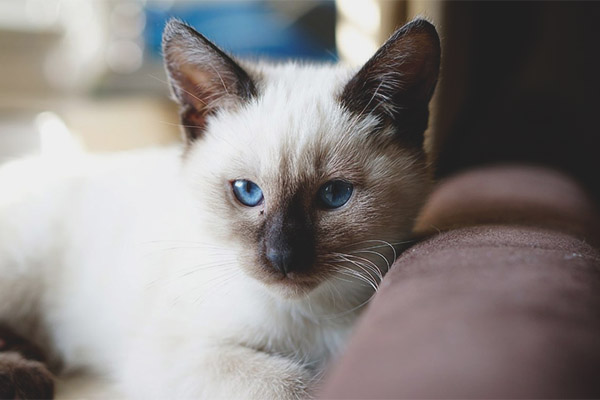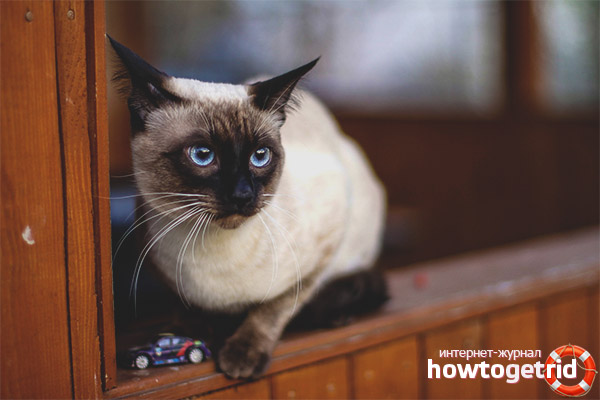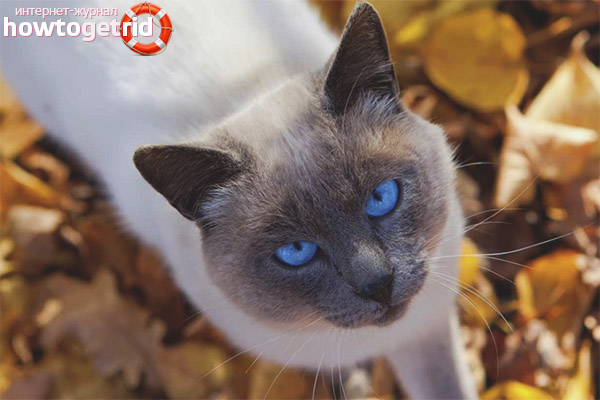The content of the article
Cats of this breed have a very expressive and harmonious appearance. Their bottomless blue eyes create a bright contrast with wool, adorned with smooth transitions from light to dark, with the now fashionable ombre effect. Today, many breeds of cats have similar colors. However, in addition to attractive colors, the Thai cat also has a number of additional benefits.
From the history of the breed
As the name implies, Thailand is considered to be the birthplace of the Thai cat. This breed of cats was bred by breeders with the participation of traditional Siamese. The process has changed: colors, face and body of the animal.
On the territory of post-Soviet countries, cats of this breed are very popular. Where were introduced around the 18th century traders.
In Europe, the Thais appeared in the 70s of the 19th century with the help of a British official named Owen Gould. They were presented to him by the King of Siam as a sign of a positive attitude. Thai cats made a stunning impression on visitors to the London Cat Show. And the English breeders with great zeal began to engage in their breeding.
After some time, the animals of this breed spread throughout the world. In the 1900s, they appeared in the United States. In Europe, the breed continued to be bred, and in 1990, the Thai Cat Breed was officially recognized by the World Cat Federation, and standards were approved in 91.
Description
Thai cats are extremely easy to confuse with Siamese. This is absolutely justified, since these animals are the ancestors of the Siamese and inherited some of their external characteristics. But this is only at first glance. In fact, the differences between the breeds are quite significant.
External characteristics of Thai cats in accordance with generally accepted standards:
- Torso It has medium size. With sufficiently developed muscles. Distinguished by harmony and harmony.It is not lean and not fat.
- Head. It has a wedge shape and soft rounded contours. The tip of the nose forms a right angle along the line of the forehead.
- Paws. Medium size. The tips of the paws are rounded.
- Eyes. Large and expressive. Almond shape. The outer corner of the eyes is slightly raised towards the ear. Be sure to saturated blue.
- Ears. They are medium in size and rounded at the ends, with a wide base. Widely set.
- Tail. It has an average length and wide base. Gradually tapering towards the end.
- Wool. Small (short) length, without undercoat. Tight fit to the body. Silky texture.
disadvantages
The presence of a thick undercoat, pronounced cheeks, eyes are round. These characteristics indicate mixing with other breeds, which is highly undesirable.
Colors
Thai cats have many choices of colors. Characteristic is the presence of an important pattern - color type marks - point. The body has a lighter tone, and paws, tail, muzzle several tones darker.
Nature gave the Thais the following acceptable color options:
- Blue point Light color with a bluish tinge wool. Dark gray tail, muzzle, ears, paw tips.
- Chocolate Point The color of the main coat on the body is ivory. Chocolate-colored markings according to the type of color - point.
- Tortie point Markings are turtles. The body is a standard monochromatic color. In this color, such basic shades as tortoise color are allowed: black with red, gray with cream.
- Cream Point. The combination of white body color with cream markings.
- Fawn point. White body and gray - blue markings of varying intensity.
- Lilac point Wool has a cold shade. Marking purple.
- Tabby Point The markings are arranged according to the color-point type, with a pattern characteristic of tabby colors.
- Red Point The body is white with red markings.
- Force point Dark brown body and black markings.
Character traits
All the character traits of the Thai cat are derived from ancestral breeding. However, each individual cat has its own inner world and individual combination of character traits.
Thai cats are energetic and active. They can remind dogs of their behavior. Representatives of this breed do not like to hide in a secluded place in anticipation of the caress of the owner. Instead of quietly lying on the couch, a cat of this breed will actively explore the nooks of the house, hunt and play. For such an active pet, the future owner should take care of the equipment of the personal space for the animal in advance. It is desirable that in the house for him was a special area with the presence of a scraper.
These smart cats are often very neat about the children of the family in which they live. In addition, they are very sociable and love to play. Therefore, if a child wants to be presented with a kitten, a Thai cat is a wonderful option.
These animals are emotional and sociable character. They like to accompany the master in his daily activities. In addition, Thai cats are tied to their human comrade, they are simply impossible to entrust to another person if necessary.
Thai cats have uncommon intelligence - one of the highest among the representatives of the cat relatives.They are perfectly amenable to training and teaching teams.
It is worth noting that the Thai cat is a very talkative creature. They conduct a dialogue with the masters using various purring intonations. By the way, they have a very loud voice, expressive and emotionally colored. The owners usually face the lack of talkativeness of the Thais when the animal requires procreation.
Single people who do not have enough communication will be very happy to communicate with such a pet. In addition, they are very kind and sympathetic animals. Therefore, they will never leave the owner in a difficult moment, but on the contrary - they will give him maximum attention and compassion.
The nature of Thai cats has many advantages and disadvantages. However, it is worth noting that those who have gotten a cat of this breed will never exchange it for any other.
Maintenance and care
The content of the Thai cat does not differ from the characteristics of care for cats of other breeds. They are not picky in food and do not require sophisticated grooming. They are distinguished by strong and good health and a long life expectancy - about 20 years.
Wool
Hair care is quite simple. Pet needs to be combed 1-2 times a week and a little more often during periods of molting. It is simple to remove the remained wool with a wet hand, having passed it on a pet's fur coat in the direction of growth of hair.
It is not necessary and even undesirable to bathe cats. This should be done in case of emergency, no more than 2-3 times a year. In no case can not use human shampoo for cats. It is better to choose a cat or a child without fragrances.
Nutrition
The cat must be properly fed. This is perhaps the most important point of care. And feed must be balanced. In the daily diet of the animal must be meat and fish, cereals and cereals, vegetables. It is about natural food. In addition to it, you can use high-quality special food for food. Often, it is chosen animal individually, according to the needs and taste preferences. A cat needs to be given enough clean water to drink.
Restroom
Also very important detail. From the first day of the appearance of the pet in the house, you need to have a special tray for him. It can be with or without filler.Most often, the kittens go to the tray, having the filler, which was in the house of the parents. This question should definitely ask the seller. The ideal option is to use a special tray with a grid inside. As a rule, it consists of two parts: a box and a grid placed in it, which has a smaller height. Thus, the cat, visiting the tray, does not get dirty and do not wet the paws, which is an important aspect of hygiene.
Teeth care
The teeth for the predator are very important. To protect a pet from caries, it is necessary to teach him to brush teeth from an early age. This procedure should be carried out weekly using special pastes. To keep the gums strong, you need to give the cat food, which requires some effort to chew on - beef stewed cartilage, for example.
Cleaning the ears
It is also an important procedure that helps to maintain the health of the animal and its aesthetic appearance. You need to spend it every 7-10 days.
The walks
It is necessary to walk an animal. In the private sector in a closed area near the house, a pet can walk on its own if it is not threatened by anything.It is better to walk the cat living in the apartment on a special leash. Pedigree, especially valuable in breeding cats and cats, should not be allowed to independent walking. An animal can have unpleasant consequences in the form of an unwanted pregnancy in a cat. Infection with venereal and other unpleasant diseases can cause the exclusion of a pet from breeding, as well as violations of both reproductive functions and health in general.
Arrangement of space in the house
Every normal cat caring owners must necessarily have their own corner for games and recreation. It must be equipped with a scraper, which must be present from the very first day the cat appears in the house. It is desirable that there were luggage equipment and a house - a secluded place to relax.
Where can I buy a Thai cat?
- The opportunity to buy an animal of a lower class for the price of the show.
- Pet health problems associated with improper maintenance, etc.
- There is always a risk that instead of a pedigree kitten, the seller will slip an animal of unknown origin.
Before buying a cat, you need to carefully examine all the documents and inquire about the reputation of the breeder in the relevant circles.
How much is a Thai cat?
The price of a kitten or an adult is affected by so many different factors. Therefore, it is rather difficult to precisely name the cost. On average, it ranges from $ 100 per pet class pet, and more than 1000 per pet class show.
Video: Thai cat













To send